初中英语阅读整体教学设计——以牛津初中英语 8B Unit 4 Reading
- 格式:doc
- 大小:57.50 KB
- 文档页数:9
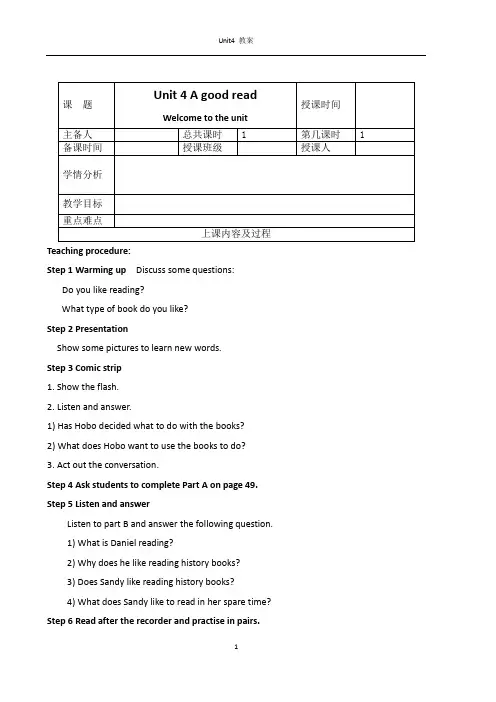
Teaching procedure:Step 1 Warming up Discuss some questions: Do you like reading?What type of book do you like?Step 2 PresentationShow some pictures to learn new words.Step 3 Comic strip1. Show the flash.2. Listen and answer.1) Has Hobo decided what to do with the books?2) What does Hobo want to use the books to do?3. Act out the conversation.Step 4 Ask students to complete Part A on page 49. Step 5 Listen and answerListen to part B and answer the following question.1) What is Daniel reading?2) Why does he like reading history books?3) Does Sandy like reading history books?4) What does Sandy like to read in her spare time? Step 6 Read after the recorder and practise in pairs.A: What do you like to read in your spare time?B: I like reading……….A: Why do you like reading……..B: Because……Step 7 Notes1. Have you decided what to do with these books, Hobo?霍波,你已经决定了怎样处理这些书吗?句中“疑问词what + 动词不定式”结构作宾语,该结构的疑问词还可用when、how、which等。
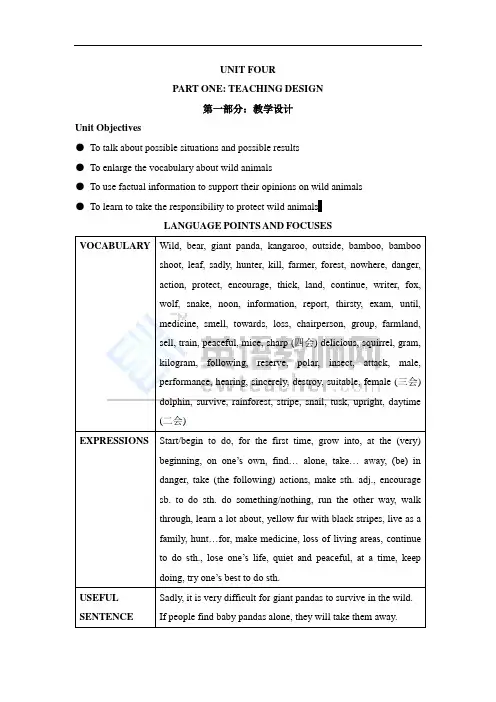
UNIT FOURPART ONE: TEACHING DESIGN第一部分:教学设计Unit Objectives●To talk about possible situations and possible results●To enlarge the vocabulary about wild animals●To use factual information to support their opinions on wild animals●To learn to take the responsibility to protect wild animalsLANGUAGE POINTS AND FOCUSESVOCABULARY Wild, bear, giant panda, kangaroo, outside, bamboo, bamboo shoot, leaf, sadly, hunter, kill, farmer, forest, nowhere, danger,action, protect, encourage, thick, land, continue, writer, fox,wolf, snake, noon, information, report, thirsty, exam, until,medicine, smell, towards, loss, chairperson, group, farmland,sell, train, peaceful, mice, sharp (四会) delicious, squirrel, gram,kilogram, following, reserve, polar, insect, attack, male,performance, hearing, sincerely, destroy, suitable, female (三会)dolphin, survive, rainforest, stripe, snail, tusk, upright, daytime(二会)EXPRESSIONS Start/begin to do, for the first time, grow into, at the (very) beginning, on one’s own, find… alone, take… away, (be) indanger, take (the following) actions, make sth. adj., encouragesb. to do sth. do something/nothing, run the other way, walkthrough, learn a lot about, yellow fur with black stripes, live as afamily, hunt…for, make medicine, loss of living areas, continueto do sth., lose one’s life, quiet and peaceful, at a time, keepdoing, try one’s best to do sth.USEFUL SENTENCE Sadly, it is very difficult for giant pandas to survive in the wild. If people find baby pandas alone, they will take them away.PATTERN Wolves won’t survive if we don’t give them good areas of forest to live in.If we continue to destroy forests to build roads, they won’t havesuitable homes.Baby giant pandas spend a lot of time drinking their mum’s milk.The number is getting smaller and smaller because many of theirliving areas are becoming farmland.If farmers keep taking the land, giant pandas will have nowhereto live.PERIOD 2: READING ITeaching Goals●To develop the ability to guess general meaning form context●To get to know the problems that the giant pandas are facing and then start tothink of way to protect the pandas●To get to know the importance of animal protectingTeaching ProceduresSTEP 1 Talking about the animalsGet the students to talk about the animals once again. Play the guessing game. Write something about a kind of animal on pieces of paper. Invite some of the students to choose and read about the animal and the others try to guess what animal it is.Guess what they are?1. They are large and heavy. They have thick fur. They like eating sweet food and fish If they are hungry, they also eat man.2.They are lovely and clever animals in the sea. They like swimming in groups. They are very friendly to people.3.They come from Australia. They jump with their babies in their special packets.4. They have yellow fur with black stripes. They are the kings of the forest.5. They are the biggest animals on land. They eat grass.6. They are small animals with big tails. They like climbing trees and eating nuts.7. They live in China. They like eating bamboo shoots and leaves very much.STEP 2 Teaching the words ‘hunter’, ‘survive’ and ‘reserve’As students come to ‘giant pandas’, get the students to talk about whatever they know about giant pandas. As they mention there are few giant pandas now, teach the words ‘hunter’, ‘survive’ and ‘reserve’.To arouse the students’ interest, get the students to guess how he avy giant pandas are at birth. The teacher can also give them some choices to choose from. (e.g. 2 jin, 500 grams, 100 grams and 1 kilogram)STEP 3 Telling the students the right answerTell the students the right answer. (They may be amazed at the information.)Say ‘I have some pictures here. They show how the baby grows into a giant panda. Can you put them into the right order?’Show them the following pictures and ask them to put them into the right order.→→→→STEP 4 Listening to the first part of the passageTell the students, ‘Millie has found a report about giant pandas. Let’s read it and learn more about the animal. But first let’s listen to the first part of the passage and answer the follow ing questions.’Who is Xi Wang? (A baby panda.)How old was Xi Wang when the writer first saw her? (10 days old.)What did Xi Wang look like? (A small white mouse.) What does “Xi Wang” mean in English? (Hope.)STEP 5 Filling in the following tableSay ‘So it’s really amazing that the baby panda is so small. Do you want to know how it grows into a giant panda? Let’s open your books and read the passage.’ Get the students to read the passage and fill in the following table.THE GROWTH OF XIWANG (PARA. 1-PARA.3)AGEWEIGHT FOODAt birth (1 day old)100 grams (100g) her mother’s milk 10 days oldlike a little white mouse 4 months10 kilograms (10kg) 8 months35 kilograms (35kg) Bamboo leaves and shoots 12 months/ 20 months / Ask ‘What did Xi Wang at different time?’ Get the students to read and find out.TIMEWHAT HAPPENED TO XIWANG At birth (1 day old)be born 4 monthsStart to go outside her home for the first time 6 months/ 8 monthsGrow into a healthy young giant pandas 12 months/ 20 monthsHave to look after her selfSTEP 6 Finishing Part CGet the students to finish Part C: the growth of Xi Wang. Look at the pictures and get the students to read the sentences here loudly. This will once again consolidate the students’ understanding of Xi Wang’s growth.STEP 7 Reading and finding out the problemSay ‘Are pandas lovely? (Yes.) However, they are now in danger. It is hard for them to survive in the wild. (Write the sentence on the board.)They are facing a lot of problems. Can you find them out?’ Get the students to read and find out the problem and what people did to solve the problems.PROBLEMS AND ACTIONS (PARA.4 –THE END)SOME OF THE PROBELMESSOME ACTIONS If hunters catch a giant panda, they willkill it for its fur. Make giant pandas reserves bigger.If farmers cut down trees and forests,giant pandas will have nowhere to live.Build more new reserves.If people find baby pandas, they will often take them away. Encourage farmers to leave the giant panda reserves.STEP 8 Finishing Part DHunters, farmers and some people did something bad to giant pandas. Get the students to say something to them.Hunters you shouldn’t kill giant pandas for their fur. AND SO ON.Get the students to finish Part D, Page 62. Check the answers.STEP 9 DiscussionDiscussion:A s a m i d d l e s c h o o l s t u d e n t,c a n y o u t h i n k o f s o m e g o o d i d e a s t o p r o t e c t p a n d a s?STEP 10 Homework: Read the passage and finish off the exercises in the books.。
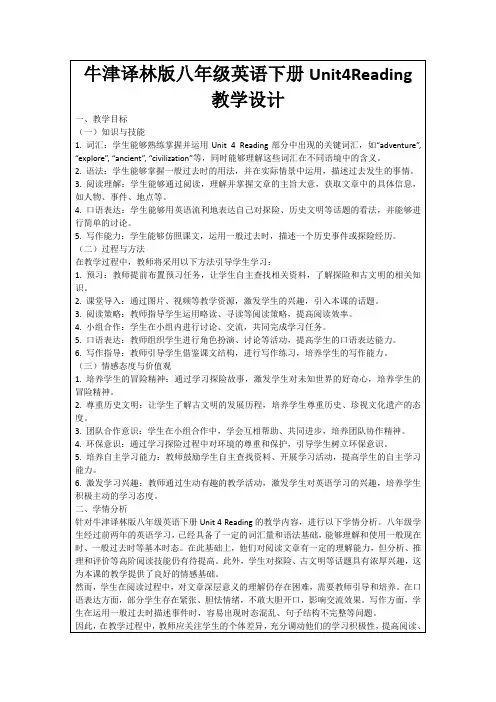
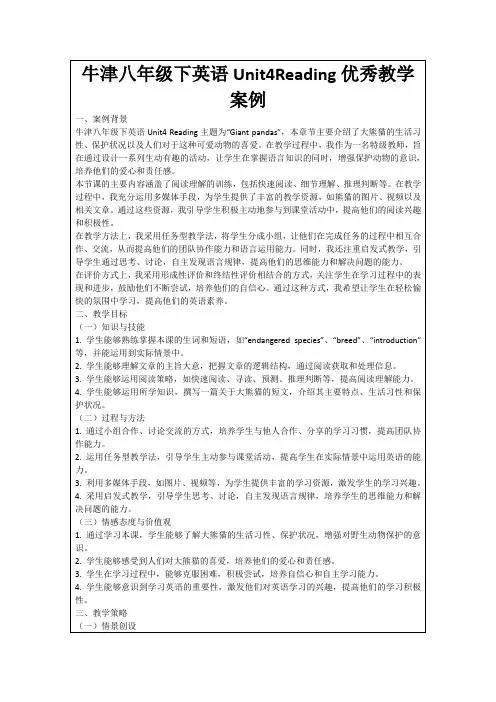
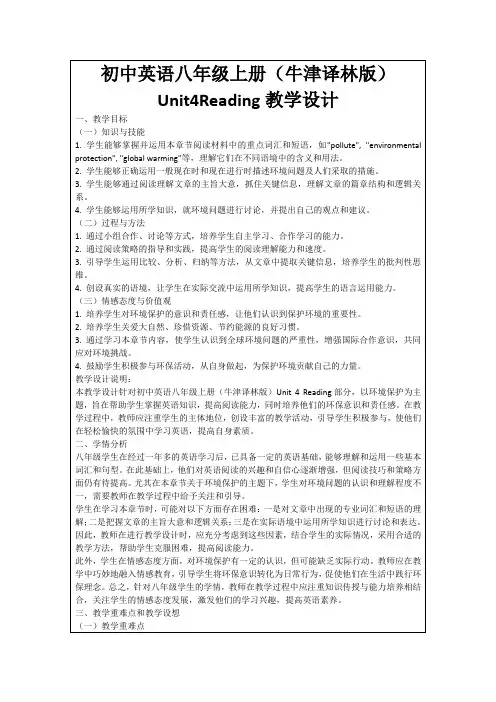
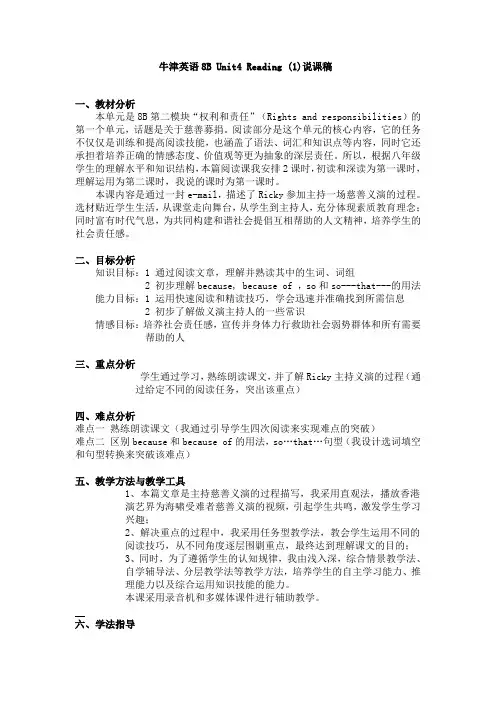
牛津英语8B Unit4 Reading (1)说课稿一、教材分析本单元是8B第二模块“权利和责任”(Rights and responsibilities)的第一个单元,话题是关于慈善募捐。
阅读部分是这个单元的核心内容,它的任务不仅仅是训练和提高阅读技能,也涵盖了语法、词汇和知识点等内容,同时它还承担着培养正确的情感态度、价值观等更为抽象的深层责任。
所以,根据八年级学生的理解水平和知识结构,本篇阅读课我安排2课时,初读和深读为第一课时,理解运用为第二课时,我说的课时为第一课时。
本课内容是通过一封e-mail,描述了Ricky参加主持一场慈善义演的过程。
选材贴近学生生活,从课堂走向舞台,从学生到主持人,充分体现素质教育理念;同时富有时代气息,为共同构建和谐社会提倡互相帮助的人文精神,培养学生的社会责任感。
二、目标分析知识目标:1 通过阅读文章,理解并熟读其中的生词、词组2 初步理解because, because of ,so和so---that---的用法能力目标:1 运用快速阅读和精读技巧,学会迅速并准确找到所需信息2 初步了解做义演主持人的一些常识情感目标:培养社会责任感,宣传并身体力行救助社会弱势群体和所有需要帮助的人三、重点分析学生通过学习,熟练朗读课文,并了解Ricky主持义演的过程(通过给定不同的阅读任务,突出该重点)四、难点分析难点一熟练朗读课文(我通过引导学生四次阅读来实现难点的突破)难点二区别because和because of的用法,so…that…句型(我设计选词填空和句型转换来突破该难点)五、教学方法与教学工具1、本篇文章是主持慈善义演的过程描写,我采用直观法,播放香港演艺界为海啸受难者慈善义演的视频,引起学生共鸣,激发学生学习兴趣;2、解决重点的过程中,我采用任务型教学法,教会学生运用不同的阅读技巧,从不同角度逐层围剿重点,最终达到理解课文的目的; 3、同时,为了遵循学生的认知规律,我由浅入深,综合情景教学法、自学辅导法、分层教学法等教学方法,培养学生的自主学习能力、推理能力以及综合运用知识技能的能力。
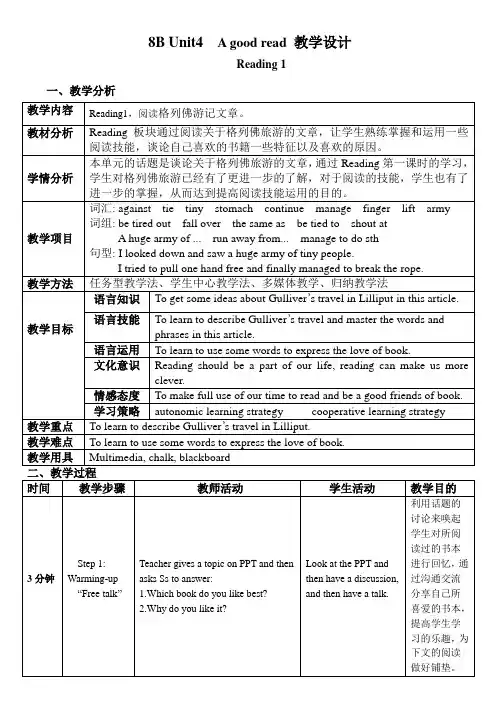
8B Unit4 A good read教学设计Reading 1一、教学分析教学内容Reading1,阅读格列佛游记文章。
教材分析Reading板块通过阅读关于格列佛旅游的文章,让学生熟练掌握和运用一些阅读技能,谈论自己喜欢的书籍一些特征以及喜欢的原因。
学情分析本单元的话题是谈论关于格列佛旅游的文章,通过Reading第一课时的学习,学生对格列佛旅游已经有了更进一步的了解,对于阅读的技能,学生也有了进一步的掌握,从而达到提高阅读技能运用的目的。
教学项目词汇: against tie tiny stomach continue manage finger lift army 词组: be tired out fall over the same as be tied to shout atA huge army of ... run away from... manage to do sth句型: I looked down and saw a huge army of tiny people.I tried to pull one hand free and finally managed to break the rope.教学方法任务型教学法、学生中心教学法、多媒体教学、归纳教学法教学目标语言知识To get some ideas about Gulliver’s travel in Lilliput in this article.语言技能To learn to describe Gulliver’s travel and master the words and phrases in this article.语言运用To learn to use some words to express the love of book.文化意识Reading should be a part of our life, reading can make us more clever.情感态度To make full use of our time to read and be a good friends of book. 学习策略autonomic learning strategy cooperative learning strategy教学重点To learn to describe Gulliver’s travel in Lilliput.教学难点To learn to use some words to express the love of book.教学用具Multimedia, chalk, blackboard时间教学步骤教师活动学生活动教学目的3分钟Step 1:Warming-up“Free talk”Teacher gives a topic on PPT and thenasks Ss to answer:1.Which book do you like best?2.Why do you like it?Look at the PPT andthen have a discussion,and then have a talk.利用话题的讨论来唤起学生对所阅读过的书本进行回忆,通过沟通交流分享自己所喜爱的书本,提高学生学习的乐趣,为下文的阅读做好铺垫。
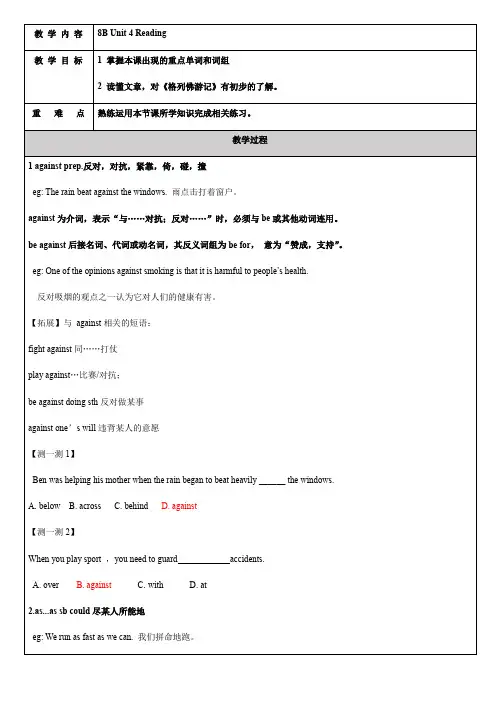
she hopes to e back possible.10 risingPeriod 21.tie2.lift3.continued4.stomach5.against二,6.feet 7.unable 8.1o break 9.to get10.early三、11.B 点拨:本题用句意理解法。
根据上句可以判断本旬句意为"嗯,直到完成作业,我才会上床睡觉". not...until 意为“直到.....·才",固定搭紀.故选B,12.C 点拨:在末尼表示香定的"也”用either13.A 点拨:句意:虽然不同意我的观点.但老教授没有提出他口己的观点,against有“反对”的意思,符合句意.14.C 点拔:本题川固定句型法解题。
考查形容词的比钕等级。
" one of the + 形容词的服高级+可数名词的复数形式”表达“最·.·之一";能够修饰形容问比佼级的词有 much,even,far,a little,a bit.a lot等。
15.D 点拨:木题用辨析法解题.句意:一一哦,我的天啊! 我把钥匙落在屋里了,我不得不从窗户里进大。
一一这很危险。
你最好等你妈妈川米through意为"穿过、通过",表示从某个范川的一端到另一端,强调动作是从物体的内部经过,往往指穿过森林,窗户窖。
故选D.四16.fall over17.crashed against18.was tired out19.managed to reach20.has been away from; as soon as。
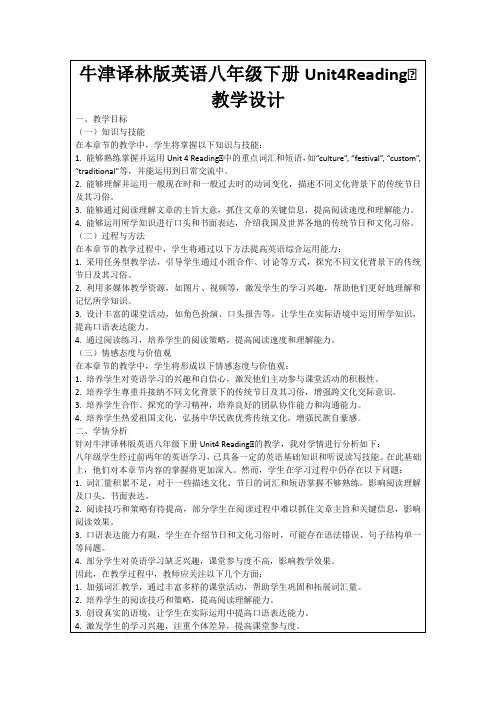

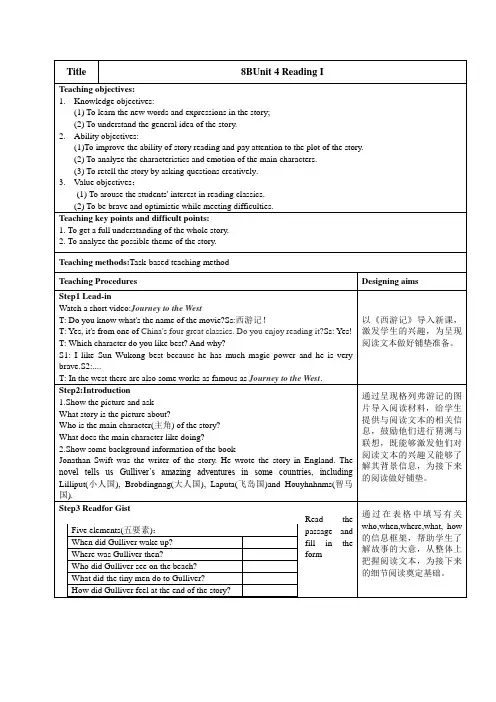
牛津初中英语8B 第4单元Reading[教材分析]8B第4单元是关于野生动物的一个单元,通过本单元让学生了解到各种野生动物的特点和生活习性。
本课时是整个单元的第二课时,是一堂阅读课,是关于大家喜爱的大熊猫的故事。
本课让学生学习一篇介绍大熊猫幼仔的早期生活的文章。
文章第一部分用第一人称的口吻描述作者观察到的大熊猫幼仔的早期生活。
文章的中段,虚实风格换成一种比较客观的含有说服力的基调。
文章第三部分谈论保护大熊猫的一些措施。
特别是第三部分探讨如何保护大熊猫的措施,由课内延伸到课外, 增大学生的知识量, 拓展学生的思维, 达到综合运用语言进行交际的目的。
[教学目标]1、知识目标:1)了解文章的大意,弄清楚文章的结构; 2)了解每部分的中心思想2、能力目标:1)培养学生表达观点的能力;2)培养学生合作探究和解决问题的能力3、情感、态度价值观目标:1)唤起学生对野生动物的关爱,增强保护野生动物的意识;2)鼓励学生想办法,采取措施来保护野生动物[教学重点]1)了解大熊猫的生活情况2)通过阅读,理解课文大意并理清事情发生的顺序。
3)合作探究大熊猫的保护措施[教学难点]培养学生用英语口语表达自己的观点,发展说的能力,深入挖掘文章。
[教学过程]Step1 Warming upPlay a guessing gameT: Do you like animals?S: Yes.The teacher presents some statements in the bubbles on the screen and asks the students,“What animals are they?”e.g.“It jumps with its baby in its pocket. You can see it everywhere inAustralia.”(kangaroo)a)“It is the biggest animal on the land. It has two big ears and it can carryheavy things.”(elephant)b)“It is a small animal with a long thick tail and red, grey or brown fur. Iteats nuts and lives in trees.”(squirrel)c)“It is a horse from Africa, with black stripes on its body.”(zebra)d)“Its fur is black and white. Its body is fat and round. Its favourite foodis bamboo.”(giant panda)…The students put up their hands and tell the answers.[设计意图:通过根据一小段英文的叙述来猜是哪一种动物,激发了学生兴趣,锻炼了他们的英语理解能力,既复习了本单元第一课时所学的一些动物,又通过猜出大熊猫,自然延伸到新课学习,为下一步新课的导入埋下了伏笔,起到承上启下的作用。
案例采撷初中英语“以读促写”教学案例———以牛津版英语七年级下册Unit4的Reading板块为例文|杨培一、教学背景“以读促写”教学模式在课堂教学中得到广泛的关注,通过结合阅读和写作两大板块的内容,能够在阅读中实现对文本的深入分析,牢固掌握文本中的语言表达方式、前后衔接方式等内容,并且在写作过程中将其灵活运用,以此促进学生阅读能力以及写作水平的双向提升。
但是,就初中英语教学实践活动的开展来讲,阅读和写作割裂的问题依然存在,很多教师在教学中仍将阅读和写作当成两个独立的部分展开教学。
为了提升英语写作教学的有效性,促进学生英语学习综合能力的提升,教师在英语教学中要积极转变自身观念,优化英语课堂教学路径,促进课堂教学模式的革新,在解决写作教学中存在问题的基础上,提升学生的写作能力,让作文课堂更具效能。
借助“以读促写”教学模式能够实现阅读和写作的有机结合,避免教学中出现读写分离的情况,能够引领学生在参与中促进自身能力的提升。
本文以牛津版英语七年级下册Unit4的Reading板块为例,论述了“以读促写”教学模式在初中英语课堂中的应用。
二、教学设计(一)教学内容本次教学设计语篇内容选自牛津版英语七年级下册Unit4的Reading板块,该单元主题围绕“Save the trees”展开,语篇主线为“How do trees help us”。
就文章结构而言,一共有3个自然段,针对树木在人类生活以及环境保护中的重要性进行了深入的阐述。
文章在描写树木重要性的基础上,进一步升华了主旨,引导读者展开想象,如果这个世界没有树木会怎么样,从而号召更多的人参与到保护树木的队伍中。
针对该语篇文本中的内容而言,有很多非常细节化的内容。
因此,在读写课堂教学活动中,为了提升教学成效,发挥“以读促写”在读写教学中的价值,针对教学设计而言,将更多的重点放在如何提炼和归纳文本信息方面,让学生通过总结文本中的关键词,实现对文本中心大意的把握,在更好归纳文章整体内容的基础上,进一步促进学生思维的延伸和拓展,从而能够将所学内容运用到今后的英语学习中,拓展“以读促写”教学的深度,为学生英语运用能力的提升提供更有力的支撑。
2013年说课决赛说课稿广州市第115中学陈敏一、教材分析(The analysis of the text)本课是初中牛津英语8BU4 Reading A Educational visits的教学。
为阅读课,全文由三篇围绕同一主题的文章组成。
关于教学交流的话题,学生平时接触得不多,尤其是城乡结合部的学生,没有亲身接触过,甚至完全没有概念,这也对课文的理解造成了一定的障碍。
本单元在Reading A就直接介绍了Educational exchange的实例(Reading B才介绍此意义,在常规教学中,建议先学习Reading B),在学生对其没有概念的前提下进行本课的教学有一定的难度。
一般情况下,单元中的Reading A是一个单元的基础,联系着语法,听说和写作,而在横向看,本节课涉及到的内容则相对独立,和单元学习的其他模块没有太大的联系,就纵向看,关于educational exchange这个话题,没有在其他分册中再出现,所以,本课的定位就是让学生了解这个题材,尽量通过阅读练习充实这部分的内容。
八年级的英语教学更多地偏重于阅读技能的训练和提高,本课将以此为主要目的,输入阅读信息和阅读微技能,最后以输入信息为基础进行口头语言输出,作为对文章掌握情况的反馈。
二、学情分析(The analysis of the students)八年级学生经过中学一年的学习,他们对初中英语的学习有了自己的了解和定位,他们有极强的形象思维能力,好奇心强,上课的注意力容易被吸引,但也容易分散,所以,保持他们的注意力是课堂实效的关键,他们对阅读训练很熟悉,却并没有系统的掌握其技能,他们已经不满足于老师简单重复的1说教,更不喜欢整节课都在做题目,他们亟需引导和启发。
三、教学目标及课程说明234。
牛津英语8Bunit4 reading部分说课稿2胡玉杰Ma Chang Middle School Shu Yang County Jiangsu province Teaching material analysisThis unit is part of the rights and responsibilities for the first unit,Topic is about the charity. Reading part is the key of this unit. The task is not only a training and improve students’ reading skills, and also covers grammar, vocabulary and knowledge and so on. At the same time It’s also to cultivate correct values, attitudes, etc. According to the characteristics of the teenager students, I divide the class into two classes. First class is for the reading, to understand the article. The second is for language points. Today ,I want to share my teaching ideas is first lesson. This article describes the process of Ricky hosting a charity activity by an e-mail This topic is very close to the students, students can be cultivated a sense of responsibilityTarget analysis1 Knowledge goal : master the key words and phrases through reading articles2 Abilities goal: using fast reading skills to answer a few questions3 Emotion aims is to cultivate the students' sense of responsibility, let them to help those who need helpDifficult and important points analysisLet the students read the text, to understand the process of charity activitiesLet students understand the differences between because and because ofStudying methods instruction. Reading is the main task of this period time.Therefore, guiding students to use fast reading to grasp the general idea of article, and through the comparison of examples, let the students find the difference between because and because of and to cultivate students' ability of the ability of self-learning and encourage them to take activities in groupsThe teaching process1 Presentation we can lead in the key words of this part by presentation and arouse the student interests in learning.2 fast reading can make the students to master the main ideas of the text, and finish the answer to question3careful reading can let the students complete exercises in the book 4 Explanation explain some important vocabulary words and sentences to make the students better understand the article5 listen to the tape6 summary7 homework。
初中英语阅读整体教学设计*——以牛津初中英语8B. Unit 4. Reading第一课时为例夏苇1,祖瑞2(1江苏省宿迁市中小学教研室 223800);(2江苏省宿迁市泗洪县第四中学223900)【摘要】阅读在英语教学中占有十分重要的地位。
英语阅读整体教学设计可以培养学生阅读能力和综合运用英语的能力。
阅读前的任务设计以激活学生头脑中的图式、背景知识和预测文章内容为主;阅读中的任务设计围绕验证预测、扑捉信息,语篇分析三个部分展开;阅读后的任务设计兼顾课内,延伸课外,拓展提升用英语做事的能力。
【关键词】英语阅读;整体教学;教学设计随着社会的发展和基础教育英语新课程改革的稳步推进,用英语获取信息和处理信息的能力显得愈发重要,阅读是发展这种能力的重要途径之一,在英语教学中占有十分重要的地位。
在连续多年的教学视导中我们发现,大部分教师只局限于对教材文本语言知识的“精耕细作”,将阅读文本支解的“七凌八散”,缺乏对文章的整体理解,进而忽视了学生阅读能力的培养,发展学生综合运用英语的能力得不到保障。
因此,我们应从整体上进行阅读教学设计,让学生在参与完成读前、读中和读后的任务中掌握阅读策略,提升阅读能力,进而发展综合运用英语的能力。
一、相关概念的认识(一)整体教学整体教学是一种教学思想,是现代外语教育教学研究的重大成果,是社会发展和中学教育教学的目标对于外语教学的需要。
英语整体教学方法一定要将整体教学思想体现在教学过程之中,即做好对于教学内容的整体处理,设计多维式的分层次、多因素、有序的教学过程,发挥语言知识和语言运用能力相结合的整体教学功能等(佚名,2006)。
我们应把这种教学思想与阅读教学相结合,运用于英语阅读教学之中。
注:本文为全国基础外语教育研究培训中心课题“拓展阅读体验,有效提升中国学生英语阅读能力实验”资助子课题“初中英语合作阅读教学研究” (课题编号:2008 KT0104)的研究成果之一。
(二)教学设计一谈到教学设计,大部分老师认为就是备课,写教案。
其实不然,教学设计是分析教育教学的需求与教学的目标和要求,实现满足需求和实现目标的全过程的行动方案。
在教学设计时一定要考虑到社会发展和时代的前进对英语教育和英语运用以及我们自己学生英语学习的实际需求,同时要考虑《课程标准》对英语教与学的目标要求。
它是基于学生的发展,实施整体性和阶段性(从整个初中或高中学习阶段到每个学段以及大、小不同的单元,乃至一节课的教学)对于学生学习的发展、评价及其巩固和拓展进行详细规划的一门科学(刘兆义,2007)。
英语阅读教学设计是实现阅读的具体过程。
我们应改变对教材文本语言知识“精耕细作”的微观式教学设计,从多维的角度进行整体教学设计,指导学生在阅读中获取阅读策略,发展阅读能力。
笔者以《牛津初中英语》8B. Unit4. Reading-- Hosting a charity show第一课时为例,对“英语阅读”整体教学设计进行介绍,以期广大英语教育者共同探讨。
二、“英语阅读”整体教学设计(一)读前任务设计读前任务的目的是为了使学生通过搜集、了解与所要阅读材料相关的信息,激活头脑中的图式和背景知识,预测文中将要涉及的内容等。
通常,我们可以围绕课前准备和课堂导入两个方面设计合作任务。
1.课前准备任务设计任务1:四人或六人合作小组搜查一些慈善组织及其相关信息。
任务2:小组在网上或其它媒体搜寻并观看有关慈善演出的节目,记录其程序,写出观后感。
2.课堂导入任务设计课前准备是学生小组搜集、查询慈善机构及观看慈善演出的过程,在这个过程中,小组内的学生了解了慈善组织,欣赏,感悟了慈善演出的过程,但这仅局限于合作小组内部,为分享各小组的成果,教师可以让各小组进行成果交流展示,在展示进程中,教师可以抓住机会,巧妙的导入新课。
任务1:Achievement showsAsk each group to show their achievement.任务2:Asking and answering★ We want to raise money for Project Green Hope, what should we do?★ If we hold a charity show, what do we need to do?★ If you want to host the charity show, what will you do then?课前的准备和巧妙的导入是课堂教学成功的一半。
这一阶段,至关重要,是能否引起良好的学习兴趣,能否激发他们强烈地探知欲望,能否拥有良好的积极心理状态去感知,吸取文章的信息。
教师应结合学生实际情况,正确引导学生动手收集与文章内容有关的信息材料,教师也适时提供相应的背景知识介绍,让学生更好地了解中西两方面文化差异和文章内容的特点等。
(二)读中任务设计阅读的主要目的是从篇章中获取主要信息。
教师应善于利用信息转换手段,设计有效的任务和活动,以完整的视觉表象形式将课文的主要内容、人物和事件、故事的发展过程和场景等生动、清晰的呈现给学生(杨延从,2007)。
在阅读教学中,许多教师往往注重的是对文本语言知识的“精耕细作”,而学生阅读能力的培养却被忽视了。
也就是说,老师们在处理文本语言知识与学生能力培养之间的关系时存在严重的偏差。
试想,一篇文章都被我们支离破碎地讲解“透”了,再给学生一些问题来回答,还谈得上阅读能力的发展吗(祖瑞,2008)?程晓堂(2006)对此曾作了精辟的论述,他认为:必须明白课文的首要功能不是作为知识的载体;课文首先是用来阅读的;阅读的目的主要是培养阅读能力,其次是提供语言输入和文化输入。
因此,课文教学,特别是第一课时,我们要从整体理解课文的角度设计任务。
在阅读的进程中,我们可以从验证预测、扑捉信息,语篇分析三个部分设计任务。
1.验证预测任务1:Guessing what the main idea of the text is?任务2:Skimming and proving2.扑捉信息扑捉信息主要是指抓文章细节,通过细节归纳文章的主题思想。
任务1:Scanning and answering in pairs★ Who was choosing to be the host?★ Where was the show held?★ Was the show a success?任务2:Reading and matchingRead the text carefully and write down some notes on a piece of paper, tear it up by mistakes. Then give them to another group and ask the group to match the two halves of the sentences.通过上述两个任务,学生迅速扑捉了文章中的重要信息或事实,对文章的细节抓的很准,很到位。
但把握文章的主题思想是阅读的重要内容。
归纳主题思想是一项十分重要的阅读技能,它体现了学生总结和概括的能力(杨延从,2007)。
就像学语文一样,我们也应引导学生通过对段落的划分来归纳本文的主题思想。
任务3:Reading and distinguishingRead the text again, discuss and fill in the table in groups.3.语篇分析抓住了文章的主要信息,找准了文章的事实细节,把握了文章的主题思想之后,大部分教师和学生认为阅读的任务完成了。
实际上,我们学习、阅读文章不能只满足于潜层次的理解,对于深层次篇章的逻辑结构和谋篇布局更要搞清楚,只有这样,我们才能提高学生的写作水平。
因此,在阅读教学中,教师要引导学生去分析文章的逻辑结构和谋篇布局。
所谓语篇分析是指从整体理解语篇内容入手,分析句子与句子之间,段落由于段落之间的衔接方式、逻辑思维的连贯方式以及语言形式方面的内在联系,它不同于传统的句子结构分析,它重视语言所表达的思想内容和艺术特色(张献臣,2009)。
任务1:Discussing and identifyingAsk each group to discuss and identify the structure of the text. Show them thefollowing structures.任务2:Discussing and making a flow chartAsk each group to discuss and make a flow chart that helps them understand the structure better.(三)读后任务设计上述一系列的任务设计都是围绕课文内容而展开的,学生的思维活动带有一定的局限性,为了培养学生的创造性思维能力,加深学生对课文的理解和分析能力,读后的任务设计是不可或缺的。
这一部分的任务可以根据需要设计课内和课外两种形式。
通常,课内的任务设计可以是有指导性的半控制任务,如摘取部分情节,让学生自编对话,分角色表演,或使用其他人称复述课文,或联系实际改编文章结尾,或书写读书笔记等;课外的任务则可以是开放性的,如有的文章涉及到环保问题,可让学生联系生活实际,提出自己的观点和措施,做好调查,如何预防,打击,破坏自然环境等问题。
在掌握知识,发展能力的同时,对学生进行德育内容的渗透,让学生在思想上得到良好的熏陶。
任务1:An interviewAt first, you can interview others in your own group, then exchange the group.这项任务适用于课内开展,各组学生不光要自己设计访谈问题,还要为接受别组的采访而准备,可以有效的激励学生去记忆课文内容,思考问题。
任务2:Discussing how to organize a charity showYour class is also organizing a charity show. Talk about the show in groups and make a plan.任务3:Organizing a charity showHave a meeting and discuss which group’s plan is the best. Then choose the right time to hold the charity show.这是具有创造性的两个任务,对发展学生思维的广阔性、灵活性和深刻性有很大的帮助。
组内讨论计划,每个人都可以自由发表意见,陈述理由;班内确定方案,各组代表都能够慷慨激昂,据理力争;举办慈善义演,人人参与,个个奉献,体现了参与慈善事业的主人翁意识,提高了用英语做事的能力。